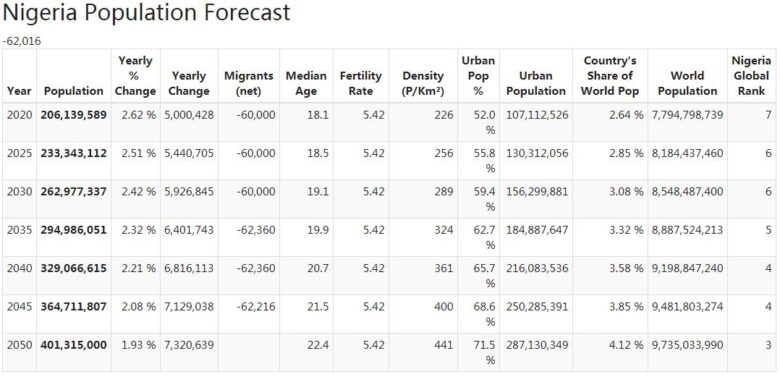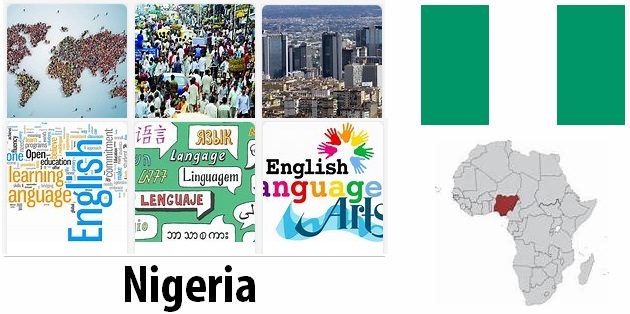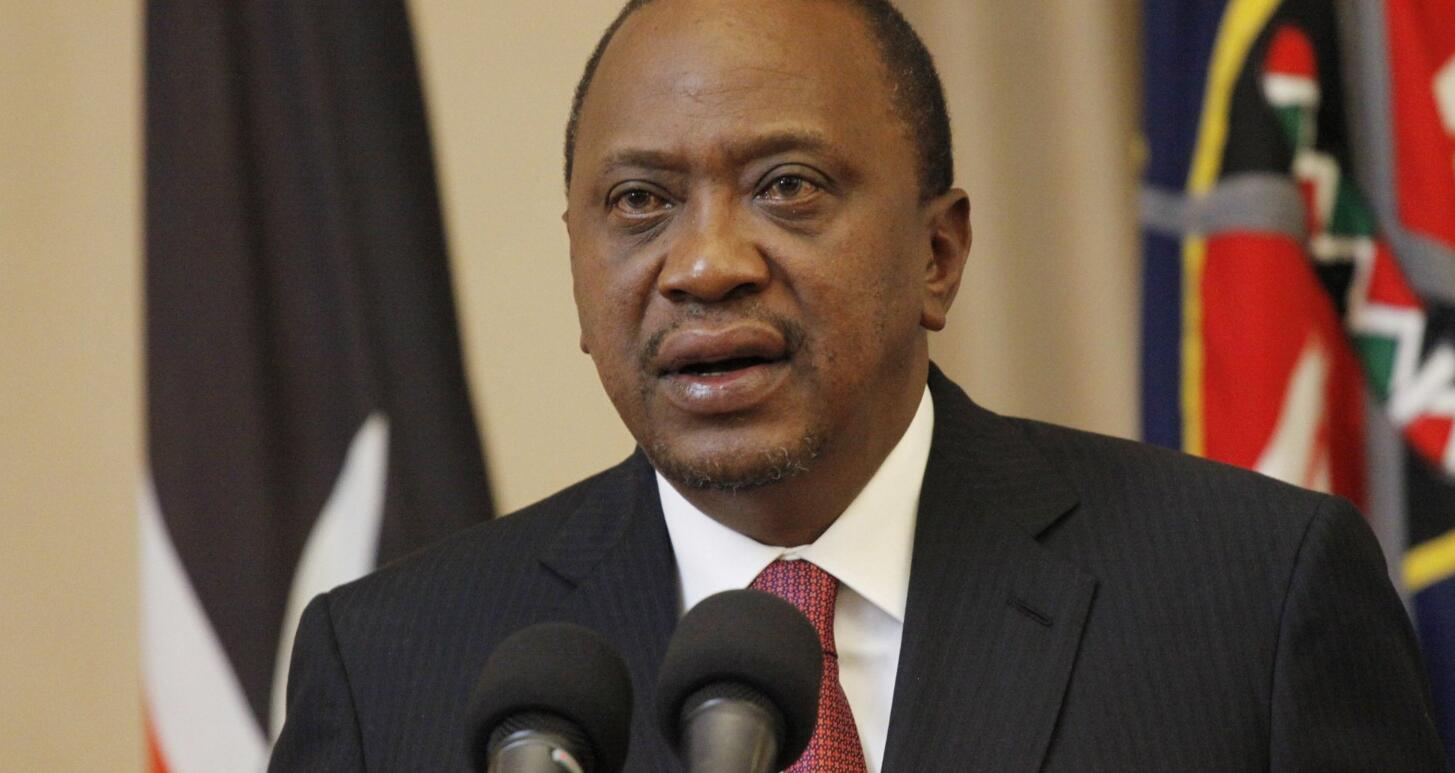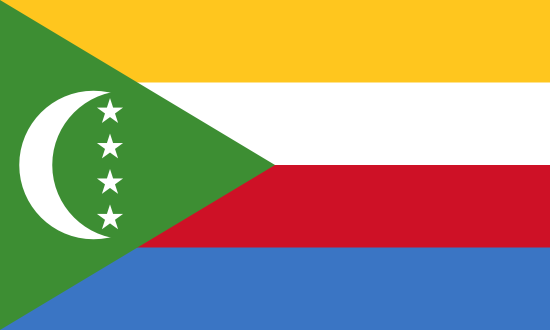Nigeria Population and Language
Nigeria is Africa’s most populous state and is estimated to have the world’s seventh largest population. The population figure is uncertain and has often been a matter of dispute because of the sensitive ethnic and religious balance. The number of people groups is usually stated at over 250. More than two-thirds of the residents belong to one of the three dominant groups hausa-fulani, yoruba and igbo.
A large part of Nigerians live south along the coast. The Niger Delta is very densely populated, and Lagos farther west is one of the world’s largest metropolises with perhaps 20 million residents. The area around Kano in the north is also densely populated. Large parts of the country in general, not least its interior, are quite sparsely populated.
- COUNTRYAAH.COM: Key populations estimated size and data of Nigeria, including population density of how many people per square mile. Also included are facts for population and language.
The censuses that have been carried out have been followed by protests and accusations of cheating. The issue is loaded because federal funds are paid out depending on the population of a state. In the 2006 census, people refrained from asking questions about ethnicity and religion. It is certain that the population is growing rapidly, although the pace has slowed in recent years. Around 45 percent of the residents are under 15 years of age.
Information on the number of ethnic groups in Nigeria varies because it depends on how you count. A common characteristic of an ethnic group is said to be a common language, but the boundaries between languages and dialects are fluid. Some sources count over 500 languages in Nigeria. The larger people groups are usually divided into subgroups, tribes, clans etc.
Three large groups of people
Hausa is the dominant people in the north. For centuries, however, livestock-fed fulani have immigrated and mingled with hausa, who lived by agriculture and commerce (compare Older History). Today, the two groups are often referred to as Hausa-Fulani, and together they make up about a third of Nigeria’s population. Hausa-fulani are Muslims as well as kanuri, another larger group in the north living near Lake Chad.
Yoruba (just over a fifth of Nigeria’s population) and igbo (or ibo, just under a fifth) are the two large groups of people in the south. Both have traditionally been farmers. Yorubaland encompasses southwest Nigeria. Igbo lives in the southeast but is also scattered throughout the country. Almost every major city has an Igbo minority. Among Yoruba are Christians, Muslims and followers of Yoruba’s traditional religion. Most Igbo are Christian.
Hausa in the north and Yoruba in the southwest had their own states even before the arrival of Europeans in the 1400s. Yoruba was early Black Africa’s most urbanized people. Igbo, on the other hand, were rarely organized into larger units than a group of villages. During the colonial era, igbo through the Christian mission schools received an educational advantage over other ethnic groups.
Near Yoruba live the closely related edo or bini, and near Igbo live ibibio-efik which is strongly influenced by igbo. In the oil-rich Niger Delta in the south lives ijaw (ijo), which is often said to be the fourth largest people in Nigeria, as well as several smaller people groups such as ogoni, urhobo and etche.
In central Nigeria, perhaps 180 different groups of people live, of which the largest are tive and nupe.
Ethnic contradictions
Nigeria’s oldest parties represented different ethnic groups. It was also ethnic contradictions that led to the Biafra civil war in 1967-1970 (see Modern History). In 1979, it was therefore decided that every party wishing to stand for election must receive support from all parts of the country. But the ethnic, political and religious conflicts, which are often linked to land disputes, have continued. Poverty and social insecurity reinforce the tendency to identify with one’s own ethnic group. Contradictions between different groups have intensified since democracy was reintroduced in 1999. Thousands of people have since been killed in violence and hundreds of thousands have been forced to flee their homes. The situation is made worse by the fact that the Constitution makes a distinction between “natives” in a certain area and “settlers” who have their roots in another part of the country – even if they go back several generations. Natives have certain privileges, such as better access to political records and public jobs.
During the 2010 century, the Islamist terrorist group Boko Haram has driven hundreds of thousands of people away from their homes, mainly in the state of Borno in the northeast. Most have moved to the cities, not least the state capital Maiduguri where some are housed in collection camps. More than half of those affected are children. Many have also sought refuge in Cameroon, Chad and Niger. According to UN estimates, there were approximately 2.5 million refugees in the region at the beginning of 2018. The vast majority, 1.9 million people, are internally displaced persons in Nigeria (see Current Policy).
language Diversity
Nigeria’s official language is English. English is taught in elementary school and is a language of instruction at higher levels and at universities. In order to bridge the language barriers between different peoples, not only regular English is used, but also in the south an English-based mixed language, pidgin, while Hausa is the general language of socialization in the north. Many Nigerians speak Hausa, Pidgin and / or English in addition to their mother tongue.
Most of Nigeria’s languages belong to the large Niger-Congo group, where yoruba and igbo and others are included in the kwa subdivision. Hausa, on the other hand, is an Afroasiatic language, very closely related to the Semitic languages, while Kanuri is a Nilo-Saharan language.
FACTS – POPULATION AND LANGUAGE
Population
hausa-fulani (about a third), yoruba (just over a fifth), igbo (just under a fifth), among others ijaw, kanuri, ibibio, tiv
Number of residents
190 886 311 (2017)
Number of residents per square kilometer
210 (2017)
Percentage of residents in the cities
49.5 percent (2017)
Nativity / birth
38.9 per 1000 residents (2016)
Mortality / mortality
12.5 per 1000 residents (2016)
POPULATION GROWTH
2.6 percent (2017)
fertility rate
5.5 number of births per woman (2016)
Percentage of women
49.3 percent (2017)
Life expectancy
53 years (2016)
Life expectancy for women
54 years (2016)
Life expectancy for men
53 years (2016)
Language
English is the official language; hausa, yoruba and igbo are major regional languages, in addition to up to 500 local languages.




